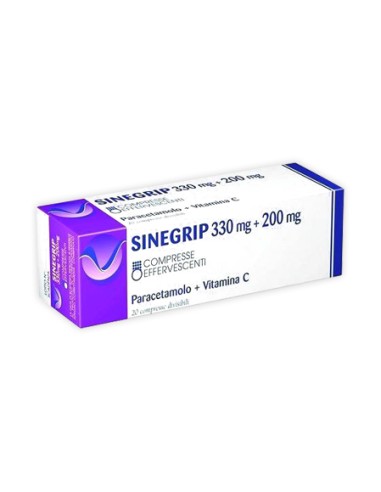Your cart
There are no more items in your cart
- 37%
SINEGRIP 20CPR EFF 330MG+200MG
035755014
Out-of-Stock
€3.49
€3.49
€5.50
-€2.01
€3.49
SINEGRIP 330 MG + 200 MG COMPRESSE EFFERENCES
active ingredients
An effervescent tablet contains: Active ingredients: paracetamol 330 mg sodium ascorbate 224 mg corresponding to vitamin C 200 mg. For excipients see paragraph 6.1Excellent
Citric acid, sodium bicarbonate, sodium, sodium carbonate anidro, aspartame, orange aroma, lemon aroma, dimeticone, polysorbate 20, povidone.Therapeutic indications
Symptomatic treatment of painful affections of all kinds (e.g. headaches, toothache, torquel, neuralgias, joint and lombosacral pains, menstrual pains) and feverish and cooling affections (influence and cold conditions).Contraindications
Hypersensitivity to active ingredients or any of the excipients. Patients with manifest insufficiency of glucose-6-phosphate dehydrogenase and those suffering from severe hemolytic anemia. Severe hepatocellular failure. Children under 7.Population
Adults (over 15 years) 1-2 tablets 3 times a day in a glass of water with a minimum interval of 4 hours between one intake and the other. Children and boys . - 7 to 13 years. 1⁄2-1 compressed 1-3 times a day in a glass of water; - from 13 to 15 years 1 -1 and 1⁄2. compressed 1-3 times a day in a glass of water. In children from 7 to 12 years the product should be administered only after prescription and under the supervision of the attending physician. In particular, elderly patients should comply with the above minimum dosages.Conservation
This medicine does not require any special condition of conservation.Warnings
High or prolonged doses of the product may result in a high-risk hepatopathy and even serious alterations to the kidney and blood. Do not administer during chronic treatment with medications that can determine the induction of liver monooxidases or in case of exposure to substances that may have such an effect (see 4.5). Paracetamol should be administered with caution in subjects with kidney or liver failure. During treatment with paracetamol before taking any other medication check that does not contain the same active ingredient since if the paracetamol is taken in high doses severe adverse reactions may occur. Invite the patient to contact the doctor before associating any other medication (see par. 4.5). In case of allergic reactions, the administration must be suspended. Do not administer for more than 3 consecutive days without consulting your doctor. Important information about some Sinegrip excipients: Sinegrip contains aspartame, therefore it is contraindicated in case of phenylchetonuria.Interactions
In the course of therapies with oral anticoagulants it is recommended to reduce doses. Use with extreme caution and under strict control during chronic treatment with drugs that can determine the induction of liver monooxygenases or in case of exposure to substances that may have such an effect (e.g. reampycin, cimetidine, antiepileptics such as glutethymids, phenobarbital, carbamazepine). Paracetamol administration may interfere with the determination of uricemia (by the method of phosphotungstic acid) and glycemia (by the method of glucose-oxidase-peroxidase).Effects
With the use of paracetamol, skin reactions of various types and severity were reported including cases of multiform erythema, Stevens-Johnson syndrome and epidermal necrolysis. Angioedema, larynx edema, anaphylactic shock have been reported. The following side effects have also been reported: thrombocytopenia, leucopenia, anemia, agranulocytosis, alterations of liver and hepatitis functionality, alterations to the kidney (acute kidney failure, interstitial nephritis, hematuria, anuria), gastrointestinal reactions and dizziness. In case of hyperdosage, the paracetamol can cause liver cytolysis that can evolve towards massive and irreversible necrosis.Overdosing
Paracetamol, taken in massive doses far greater than those commonly recommended, can cause toxic symptomology dominated by liver damage. These intoxications should be treated by administering SH-free or free-grouping substances in the 12 hours following the intake of the paracetamol. Several products have been proposed; n-acetylcysteine seems preferable because more easily available and devoid of the secondary effects of cysteamine. Posology and 150 mg/kg/e.v. in glucosate solution in 15 minutes, then 50 mg/kg in the next 4 hours and 100 mg/kg in the following 16 hours, i.e. a total of 300 mg/kg in 20 hours.Use only in cases of actual need and under the direct control of the doctor.
Source: Farmadati
- Deductible product
- Yes
035755014
New
No reviews

